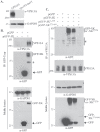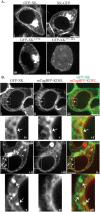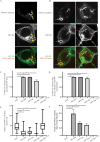XK is a partner for VPS13A: a molecular link between Chorea-Acanthocytosis and McLeod Syndrome
- PMID: 32845802
- PMCID: PMC7851852
- DOI: 10.1091/mbc.E19-08-0439-T
XK is a partner for VPS13A: a molecular link between Chorea-Acanthocytosis and McLeod Syndrome
Abstract
Vps13 is a highly conserved lipid transfer protein found at multiple interorganelle membrane contact sites where it mediates distinct processes. In yeast, recruitment of Vps13 to different contact sites occurs via various partner proteins. In humans, four VPS13 family members, A-D, are associated with different diseases. In particular, vps13A mutants result in the neurodegenerative disorder Chorea-Acanthocytosis (ChAc). ChAc phenotypes resemble those of McLeod Syndrome, caused by mutations in the XK gene, suggesting that XK could be a partner protein for VPS13A. XK does, in fact, exhibit hallmarks of a VPS13A partner: it forms a complex with VPS13A in human cells and, when overexpressed, relocalizes VPS13A from lipid droplets to subdomains of the endoplasmic reticulum. Introduction of two different ChAc disease-linked missense mutations into VPS13A prevents this XK-induced relocalization. These results suggest that dysregulation of a VPS13A-XK complex is the common basis for ChAc and McLeod Syndrome.
Figures







Similar articles
-
XK-Associated McLeod Syndrome: Nonhematological Manifestations and Relation to VPS13A Disease.Transfus Med Hemother. 2022 Jan 25;49(1):4-12. doi: 10.1159/000521417. eCollection 2022 Feb. Transfus Med Hemother. 2022. PMID: 35221863 Free PMC article. Review.
-
Interaction between VPS13A and the XK scramblase is important for VPS13A function in humans.J Cell Sci. 2022 Sep 1;135(17):jcs260227. doi: 10.1242/jcs.260227. Epub 2022 Sep 8. J Cell Sci. 2022. PMID: 35950506 Free PMC article.
-
A partnership between the lipid scramblase XK and the lipid transfer protein VPS13A at the plasma membrane.Proc Natl Acad Sci U S A. 2022 Aug 30;119(35):e2205425119. doi: 10.1073/pnas.2205425119. Epub 2022 Aug 22. Proc Natl Acad Sci U S A. 2022. PMID: 35994651 Free PMC article.
-
Human VPS13A is associated with multiple organelles and influences mitochondrial morphology and lipid droplet motility.Elife. 2019 Feb 11;8:e43561. doi: 10.7554/eLife.43561. Elife. 2019. PMID: 30741634 Free PMC article.
-
Physiological and Pathogenesis Significance of Chorein in Health and Disease.Physiol Res. 2024 Apr 30;73(2):189-203. doi: 10.33549/physiolres.935268. Physiol Res. 2024. PMID: 38710051 Free PMC article. Review.
Cited by
-
XK-Associated McLeod Syndrome: Nonhematological Manifestations and Relation to VPS13A Disease.Transfus Med Hemother. 2022 Jan 25;49(1):4-12. doi: 10.1159/000521417. eCollection 2022 Feb. Transfus Med Hemother. 2022. PMID: 35221863 Free PMC article. Review.
-
Endoplasmic Reticulum Membrane Contact Sites, Lipid Transport, and Neurodegeneration.Cold Spring Harb Perspect Biol. 2023 Apr 3;15(4):a041257. doi: 10.1101/cshperspect.a041257. Cold Spring Harb Perspect Biol. 2023. PMID: 36123033 Free PMC article. Review.
-
Red blood cell lipid distribution in the pathophysiology and laboratory evaluation of chorea-acanthocytosis and McLeod syndrome patients.Front Physiol. 2025 Mar 27;16:1543812. doi: 10.3389/fphys.2025.1543812. eCollection 2025. Front Physiol. 2025. PMID: 40213144 Free PMC article.
-
VPS13 and bridge-like lipid transporters, mechanisms, and mysteries.Front Neurosci. 2025 Apr 28;19:1534061. doi: 10.3389/fnins.2025.1534061. eCollection 2025. Front Neurosci. 2025. PMID: 40356703 Free PMC article. Review.
-
Defect in hematopoiesis and embryonic lethality at midgestation of Vps13a/Vps13c double knockout mice.bioRxiv [Preprint]. 2025 May 13:2025.05.09.653147. doi: 10.1101/2025.05.09.653147. bioRxiv. 2025. PMID: 40463036 Free PMC article. Preprint.
References
-
- Dobson-Stone C, Danek A, Rampoldi L, Hardie RJ, Chalmers RM, Wood NW, Bohlega S, Dotti MT, Federico A, Shizuka M, et al (2002). Mutational spectrum of the CHAC gene in patients with chorea-acanthocytosis. Eur J Hum Genet , 773–781. - PubMed
Publication types
MeSH terms
Substances
Supplementary concepts
Grants and funding
LinkOut - more resources
Full Text Sources
Molecular Biology Databases
Research Materials

